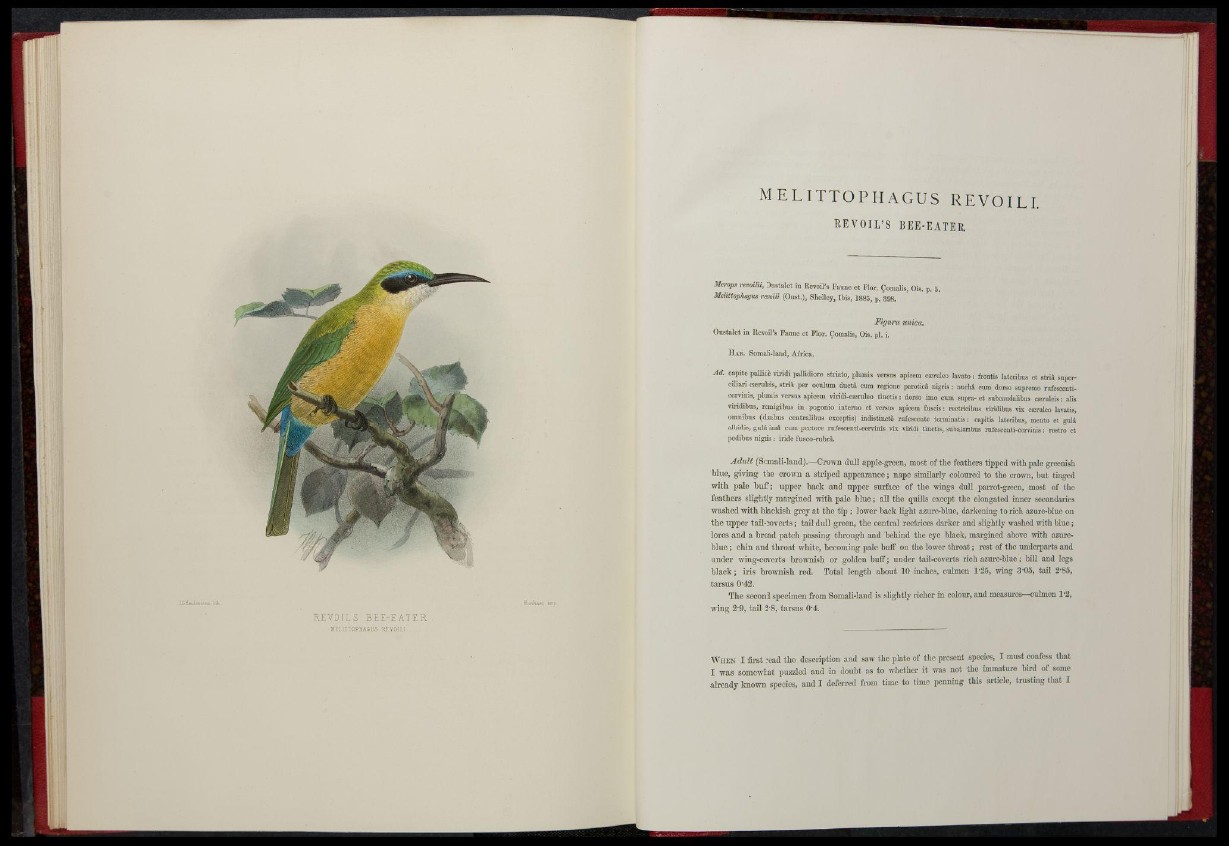
R E V O I L S B E E - E A T ER
MELITTOPHAGUS RÏVDII.1
M E L I T T O P H A G U S REVOILI.
EEVOIL'S BEE-EATEB,
Merop* revoilii, Oustalct in RcvoH's Faune et Flor. Comalia, OU. p. 5.
Melitlophagus revoili (Oust.), Shclley, Ibis, 1885, p. 398.
Figura unica.
Oustalet in Itcvoil's Faune et Flor. Çomalis, Ois. pl. ¡.
IIAB. Somalí-land, Ai'rica.
Ad. capite pallidè viriili pallidiore striato, [durais versus apiccm camdeo lavato : frontis lateribus et stria supereiliari
enruléis, stria per oculum ductfl cum rcgionc paroticà iiigris : imehâ eum durso supremo rufcsecntiecrvinis,
plumis versus apiccm viridÍ-c¡eruleo tinctis: dorso imo eum supra-et subcaudalibus ea;raleis r alia
viridibus, remigibus in pogonio interno et versus apiccm fnscis : rectricibus viridibus vis cairuleo lavatis,
omnibus (duabus ccutralibus exccptis) indistincte rufesccntc tcrminatis : capitis lateribus, mento et gulà
albidis, gula imâ cum pectore rufesccnti-cervinis vis viridi tinctis, subalaribus rufcsccuti-ccrvinis : rostro et
pcdibus nigris : iridc l'usco-rubrâ.
Adult (Somali-land).—Crown dull apple-green, most of the feathers tipped with pale greenish
blue, giving the crown a striped appearance; nape similarly coloured to the crown, but tinged
with pale buff; upper back and upper surface of the wings dull parrot-green, most of the
feathers slightly margined with pale blue; all the quills except the elongated inner secondaries
washed with blackish grey at the tip ; lower back light azurc-blue, darkening to rich azure-blue on
the upper tail-coverts; tail dull green, the central reetriccs darker and slightly washed with blue;
lores and a broad patch passing through and behind the eye black, margined above with azureblue
; chin and throat white, becoming pale buff on the lower throat; rest of the underparts and
under wing-coverts brownish or golden buff; under tail-coverts rich azure-blue; hill and legs
black; iris brownish red. Total length about 10 inches, culmen 1-25, wing 3-05, tail 2'85,
tarsus 0"42.
The second specimen from Somali-land is slightly richer in colour, and measures—culmen 1-2,
wing 2-9, tail 2-8, tarsus 0'4
WHEN I first read the description and saw the plate of the present species, I must confess that
I was somewhat puzzled and in doubt as to whether it was not the immature bird of some
already loiown species, and I deferred from time to time penning this article, trusting that I